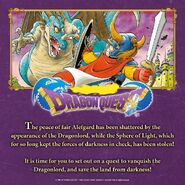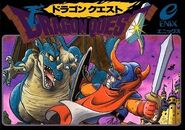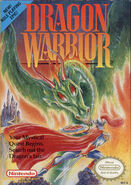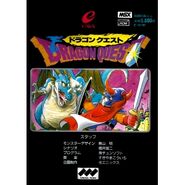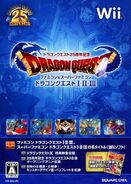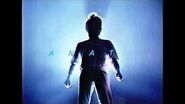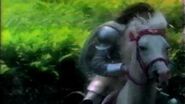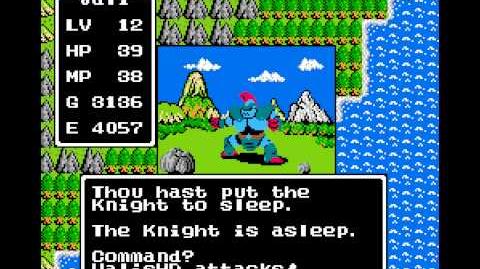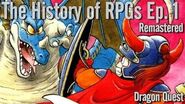- This article is about the first game in the series.
- For other works in the Dragon Quest universe, see Dragon Quest series.
Dragon Quest (originally localised as Dragon Warrior) is the first title in the Dragon Quest series. It was developed by Chunsoft and published by Enix. Dragon Warrior originally released in 1986 in Japan for the MSX and the Famicom. The game was localised for North American release in 1987, but the title was changed to Dragon Warrior to avoid infringing on the trademark of the pen and paper game DragonQuest. The North American version of the game was greatly improved graphically over the Japanese original, and added a battery-backed save feature, whereas the Japanese version used a password system. Nintendo was impressed with the Japanese sales of the title and massively overproduced the cartridge; the end result was that Nintendo gave away copies of Dragon Warrior as an incentive for subscribing to Nintendo Power, the company's in-house promotional magazine.
Dragon Quest was one of the first turn-based role-playing games to have widespread success and is considered a pioneer in the development of the genre. Along with Final Fantasy, Dragon Quest would spawn a successful franchise that would become the de facto standard for role-playing video games.
Blurb
NES version
Dragon Warrior... the epic beginning of a new era in video games.
It is the exact same, just with a slightly different name. It came out in the August of 1989.
Gameplay
Dragon Quest is one of the first console RPGs (role-playing games). The player controls a single character who is able to travel from town to town exploring on his quest. He can equip various weapons and armor and battles enemy monsters in one-on-one combat. As more enemies are defeated, the hero becomes stronger and able to explore greater distances as he completes his quest. Ultimately, the hero must defeat an evil boss marking the end of his adventure. This game formula was replicated in most, if not all, console RPGs.
Characters
- Hero: A descendant of the legendary hero Erdrick. He arrives from an unknown location to help the land of Alefgard.
- Erdrick: A hero who rescued Alefgard years earlier. Left a message for his descendant, in the cave which bears his name. (In the North American localisation, he is known as Erdrick, with similar changes to locations and items: Erdrick's Cave, Erdrick's Sword, and so on.)
- Lorik: The King of Tantegel, and ruler of Alefgard.
- Princess Gwaelin: Daughter of King Lorik. Imprisoned in the Swamp Cave south of Kol, by the servants of the Dragonlord.
- Dragonlord: The villain of the story, he has stolen the Ball of Light in order to lock Alefgard in perpetual darkness.
Name changes
The English localisation for the NES significantly altered the original names of characters and locations. Later, the Game Boy port restored some of those to better match the original version.
| Japanese Original |
NES localization |
GBC remix |
|---|---|---|
| ロト (Loto) | Erdrick | Loto |
| ラルス16世 (Lars XVI) | Lorik | The King |
| ローラ (Laura/Lora) | Gwaelin | Lora |
| 竜王 (Dragon Lord) | Dragonlord | DracoLord |
| Japanese Original |
NES localization |
GBC remix |
|---|---|---|
| ラダトーム (Ladatorm) | Brecconary | Tantegel |
| ガライの町 (Garai's Town) | Garinham | Galenholm |
| マイラ (Maira) | Kol | Kol |
| リムルダール (Rimuldar) | Rimuldar | Rimuldar |
| ドムドーラ (Domdora) | Hauksness | Domdora |
| メルキド (Mercado) | Cantlin | Mercado |
| 竜王の城 (Dragonlord's castle) | Charlock castle | DracoLord's castle |
Plot
After this terrible attack the people were terrified to walk outside again. Many men were killed traveling between places and people locked their doors at night. At night, they could hear the Slimes scratching and mumbling along the walls of Tantegel. The King fell into a deep depression over his kidnapped daughter, even though the legends told of a descendant of Erdrick coming to restore peace. The King believed it to be a myth until one day a scrawny-looking young man appeared at the King's feet and asked permission to retrieve the Ball of Light and Princess Gwaelin. Since many other hapless warriors had volunteered and failed, the King had already given up hope. But he sees a light in this young man's eyes and knew he was the descendant of Erdrick. Giving him a few items and some gold, the King sends the warrior out.
After traveling the length and breadth of Alefgard and becoming more and more powerful, the Hero eventually discovers Princess Gwaelin in the clutches of a Green Dragon, who is hiding her in a cave. After killing the dragon, the Hero lifts her onto his back and carries her all the way back to Tantegel, to the delirious joy of everyone there.
Finally, after strengthening himself through all the battles he has fought and the mystical items he has uncovered, including the immensely powerful Erdrick's Sword, the Hero enters Charlock Castle, the Dragonlord's domain, and kills him, temporarily freeing Alefgard from the terror of evil.
Gwaelin proposes to him and King Lorik offers him the throne; he accepts the former offer but declines the latter, opting instead to venture to lands unknown and found his own kingdom.
Legacy
Remakes
In the Game Boy Color remake Dragonlord's name was changed to Dracolord, and Erdrick is now known as Loto. Several conveniences were added, such as a vault for storing gold and items, and a streamlined menu system. Monsters yield more experience and gold after being defeated to reduce the amount of time needed to raise levels and save up for purchases.
The Super Famicom remake was marketed exclusively in Japan due to the absence of Enix America Corporation, but it was unofficially translated into English and Spanish through emulation by online fan translation group RPG-One in 2002. The Game Boy Color and mobile phone versions are based on the Super Famicom version.
Sequels
Dragon Quest was followed by Dragon Quest II, which met with similar success. Dragon Quest II featured the same timeline and setting as the original, a concept which was further extended into Dragon Quest III. Together, these first three games comprise what is known as the Erdrick trilogy.
Spinoffs
As the first game in the series, Dragon Quest has served as a significant influence in almost every spinoff game. In particular, many of the enemies developed for Dragon Quest (Slime, Dracky, Chimaera, etc.) are featured in almost every other game in the main series and otherwise.
Trivia
- The bonuses awarded for levelling up depend on the name chosen for the hero.
- The NES and mobile versions attempt to tell the game's story using Early Modern English. The NES version limits this somewhat even as it persists in battle, while the mobile version uses a fuller range of the language in its dialogue, but not in battle
- There is no party, only a single player character. Although his sprite changes when the princess is rescued, to show him carrying her, the princess does not participate in any battles.
- Enemies attack the hero one-on-one, never in groups.
- There are no vehicles; one can only traverse the overworld map on foot, or by using a Chimera wing or Zoom spell to travel to Tantegel Castle.
- Tantegel is the only save location in the game. Likewise, the Zoom spell can only return to Tantegel.
- Acquired weapons, armor and shields will automatically replace the previous item, which is then discarded or sold to the store. This is changed in the remakes.
- There is no helmet slot.
- Keys are consumed when used; new ones can be purchased at one of the "key houses" in Tantegel, Rimuldar, or Mercado. The first key in any quest must be purchased in Rimuldar, since the others are behind doors that require a key to open.
- There are separate shops for buying holy water, unlike later games where it is sold in item shops.
- Caves are dark, and must be lit up with a torch or Radiant spell. These have limited range, which diminishes as the spell or torch wears out. The range is effectively reduced in the remakes, since the scale of the caves is larger, but the range is not increased to compensate.
- In the original versions, there are special menu commands to climb stairs and open chests (done automatically in later games), and in the Japanese version to select directions for certain commands, since characters do not have facings in these versions.
- The original Japanese Famicom and MSX versions of this game (and Dragon Quest II) have a "Spell of Restoration" (password system), in place of the "Imperial Scrolls of Honor" (battery save system). The password does not save current HP and MP, or the contents of the chests. So all of these will be reset on a reload.
- In fact, the contents of chests aren't saved in the North American NES version either.
- In Japan, many characters, locations, and spells had different names. In Japan Erdrick was originally called Roto (or Loto), King Lorik was called King Lars, Princess Gwaelin was known as Laura, and the Dragonlord was known as King Dragon. Tantegel Castle was called Ladutorm Castle, Brecconary was called Ladutorm town, Garinham was called Galai, Kol was called Maira, and Cantlin was called Mercado. Charlock Castle was not named in the Japanese version. The Game Boy Color release of Dragon Warrior in the USA had a more accurate translation of many character and town names. Spell names in Japan were a combination of gibberish and onomatopoeia; for example, in future NES titles, the basic attack spell "Blaze" was "Mera," from the Japanese "meramera," the sound of something bursting into flames. More recent localizations of the games attempt a similar naming scheme ("Sizz," etc.).
- A myth persists that the term for the heal spell, Hoimi, became the official term for heal in Japan, though this is not actually the case. Around the release of IV, Enix held a public ceremony to "induct" the word into the Japanese language, but this was for publicity only, and the word is not commonly used.
- Erdrick's Sword makes an appearance in Final Fantasy XII as the Wyrmhero Blade (Tolo's Sword), and is the strongest greatsword in the game. The blade will only appear in the Rabanastre bazaar once three specific items are sold to it. This also marks the first time the mix of Final Fantasy and Dragon Quest has happened in the light of both Square and Enix merging to be noticed in the Western world (though the crossover had happened In the American NES version of Final Fantasy, where the grave of Erdrick can be found in the village of Elfland, as well as a few times in the Fortune Street series).
- Iti s actually possible to complete the game without saving Princess Gwaelin as it is not necessary to fight the Dragon within the cave in order to receive the three sage's items. The Ending will not have her included as a result.
Soundtrack
As with every Dragon Quest, Koichi Sugiyama composed the music and directed all the associated spinoffs. Dragon Quest I's symphonic suite was bundled with Dragon Quest II's symphonic suite and a disc of original compositions as Dragon Quest in Concert. Here is the track listing for the Dragon Quest I portion of that release:
- Overture March (3:59)
- Château Ladutorm (3:25)
- People (3:36)
- Unknown World (2:07)
- Fight (2:12)
- Dungeons (3:40)
- King Dragon (3:08)
- Finale (2:40)
Gallery
Packaging artwork
Videos
References
| v · e · dDragon Quest | |
| Playable Characters | |
| Antagonists | |
| NPC's |
Erdrick • King Lorik • Princess Gwaelin • Galen • Magog |
| Towns and Cities |
Alefgard (continent) • Tantegel • Galenholm • Kol • Damdara (formely) • Cantlin • Rimuldar • Rain Shrine • Sanctum |
| Dungeons |
Craggy Cave • Damdara • The Dragonlord's Castle • Erdrick's Cave • Galen's Grave • Quagmire Cave |
| Key Items |
Sphere of Light • Erdrick's tablet • Faerie flute • Princess Pledge • Mark of Erdrick • Lyre of Ire • Staff of Rain • Sunstone • Rainbow Drop |
| Lists |
Armor • Bestiary • Shields • Spells • Weapons • Items • Locations |
| Other | |


